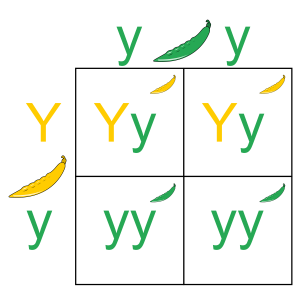Mendelian Genetics
Inheritance
Inheritance is the process by which genetic information is passed from parent to child. This is why members of the same family tend to have the same/similar characteristics.
- What have two genomes each
- We get one copy of our genome from each of our parents
- Inheritance describes how genetic material is passed on from parent to child
How is Genetic Material Inherited?
Most of our cells contain two sets of 23 chromosomes (they are diploid).
An exception to this rule are the sex cells (sperm, and egg cells), also known as gametes – which have only one set of chromosomes each (they are haploid).
However, in sexual reproduction, the sperm cell combines with the egg cell to form the first cell of the new organism, in a process called fertilization.
This (fertilized) cell now has two sets of chromosomes (diploid) and the complete set of instructions needed to make more cells – and eventually a whole person.
Each cell of the new person contains genetic material from the two parents.
This passing down of genetic material is evident if you examine the characteristics of members of the same family; from average height, to hair and eye colour, to nose and ear shape; as they are usually similar.
If there is a mutation in genetic material, this can be passed from parent to child. This is why diseases run in families.
How is Sex Determined?
The sex of an individual is determined by the sex chromosomes called the X chromosome and the Y chromosome.
Females have two X chromosomes (XX). Males have an X and a Y chromosome (XY).
Female gametes (eggs) therefore always carry an x chromosome. Male gametes (sperm) can carry either an X or a Y chromosome.
When an egg joins with a sperm containing an X chromosome, the result is a girl!
When an egg joins with a sperm containing a Y chromosome, the result is a boy!
What is a Genotype?
The genotype is a description of the unique genetic makeup of an individual. It can be used to describe an entire genome of just an individual gene and its alleles.
The genotype of an individual influences their phenotype.
For example: If we talk about the genotype for eye colour, we may say one individual has one brown eye allele (B) and one blue eye allele (b).
- As a result, the individual’s phenotype will be brown eyes
- This is because the allele from brown eyes is dominant, while the allele from blue eyes is recessive
Image by Pbroks13 – Own work, CC BY-SA 3.0, https://commons.wikimedia.org/w/index.php?curid=5013770
What is a Phenotype?
The phenotype is a description of physical characteristics of an organism. For example: when talking about eye colour, the phenotype of an individual may mean blue, brown, or green eyes.
Most phenotypes are influenced by an individual’s genotype, although environment can also play a role (nature vs nurture).
Click here for Mendelian Inheritance (includes Hardy-Weinberg Equation)






You must be logged in to post a comment.